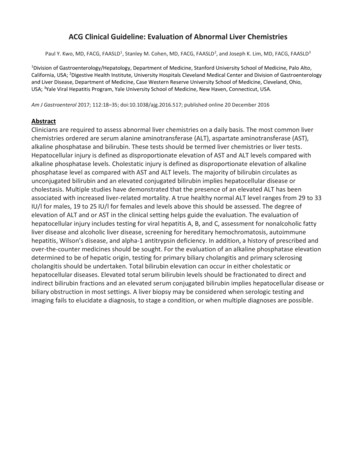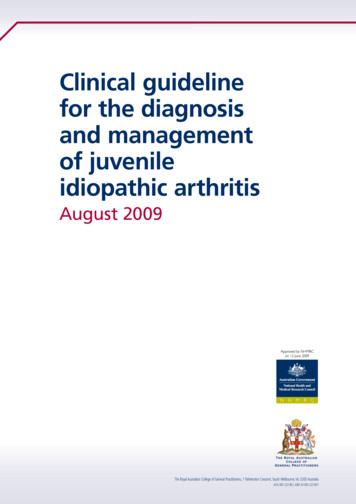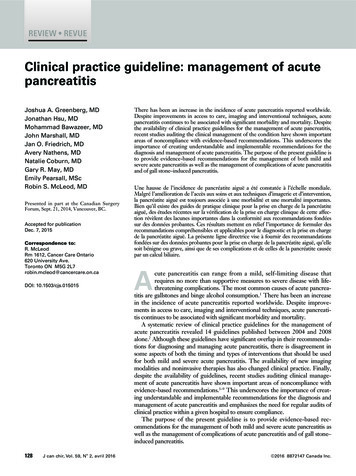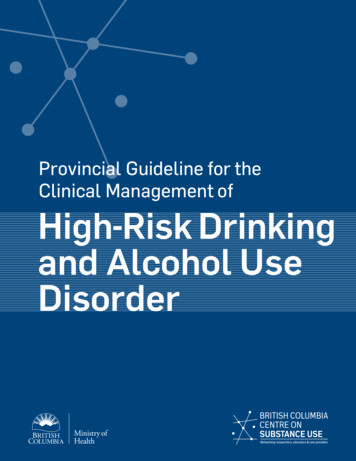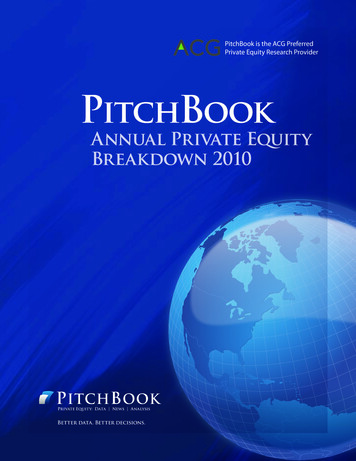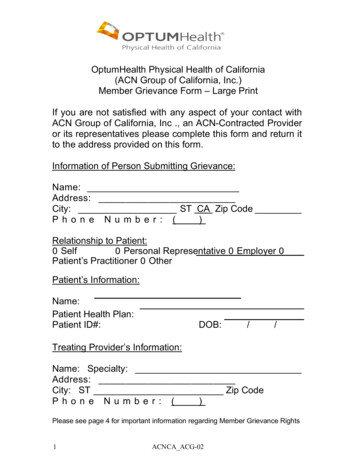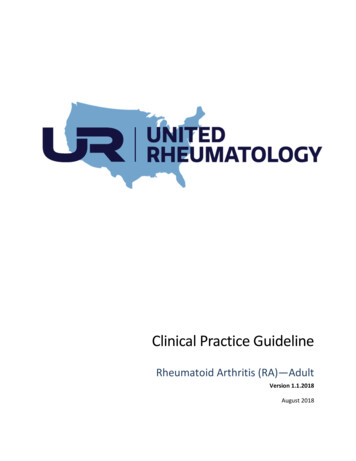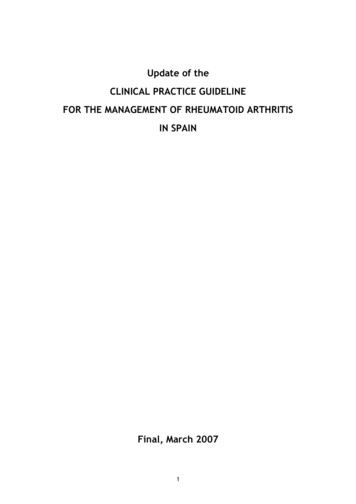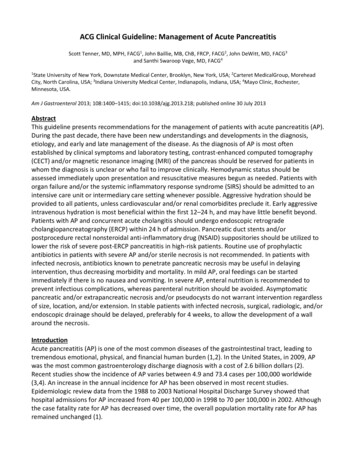
Transcription
ACG Clinical Guideline: Management of Acute PancreatitisScott Tenner, MD, MPH, FACG1, John Baillie, MB, ChB, FRCP, FACG2, John DeWitt, MD, FACG3and Santhi Swaroop Vege, MD, FACG41State University of New York, Downstate Medical Center, Brooklyn, New York, USA; 2Carteret MedicalGroup, MoreheadCity, North Carolina, USA; 3Indiana University Medical Center, Indianapolis, Indiana, USA; 4Mayo Clinic, Rochester,Minnesota, USA.Am J Gastroenterol 2013; 108:1400–1415; doi:10.1038/ajg.2013.218; published online 30 July 2013AbstractThis guideline presents recommendations for the management of patients with acute pancreatitis (AP).During the past decade, there have been new understandings and developments in the diagnosis,etiology, and early and late management of the disease. As the diagnosis of AP is most oftenestablished by clinical symptoms and laboratory testing, contrast-enhanced computed tomography(CECT) and/or magnetic resonance imaging (MRI) of the pancreas should be reserved for patients inwhom the diagnosis is unclear or who fail to improve clinically. Hemodynamic status should beassessed immediately upon presentation and resuscitative measures begun as needed. Patients withorgan failure and/or the systemic inflammatory response syndrome (SIRS) should be admitted to anintensive care unit or intermediary care setting whenever possible. Aggressive hydration should beprovided to all patients, unless cardiovascular and/or renal comorbidites preclude it. Early aggressiveintravenous hydration is most beneficial within the first 12–24 h, and may have little benefit beyond.Patients with AP and concurrent acute cholangitis should undergo endoscopic retrogradecholangiopancreatography (ERCP) within 24 h of admission. Pancreatic duct stents and/orpostprocedure rectal nonsteroidal anti-inflammatory drug (NSAID) suppositories should be utilized tolower the risk of severe post-ERCP pancreatitis in high-risk patients. Routine use of prophylacticantibiotics in patients with severe AP and/or sterile necrosis is not recommended. In patients withinfected necrosis, antibiotics known to penetrate pancreatic necrosis may be useful in delayingintervention, thus decreasing morbidity and mortality. In mild AP, oral feedings can be startedimmediately if there is no nausea and vomiting. In severe AP, enteral nutrition is recommended toprevent infectious complications, whereas parenteral nutrition should be avoided. Asymptomaticpancreatic and/or extrapancreatic necrosis and/or pseudocysts do not warrant intervention regardlessof size, location, and/or extension. In stable patients with infected necrosis, surgical, radiologic, and/orendoscopic drainage should be delayed, preferably for 4 weeks, to allow the development of a wallaround the necrosis.IntroductionAcute pancreatitis (AP) is one of the most common diseases of the gastrointestinal tract, leading totremendous emotional, physical, and financial human burden (1,2). In the United States, in 2009, APwas the most common gastroenterology discharge diagnosis with a cost of 2.6 billion dollars (2).Recent studies show the incidence of AP varies between 4.9 and 73.4 cases per 100,000 worldwide(3,4). An increase in the annual incidence for AP has been observed in most recent studies.Epidemiologic review data from the 1988 to 2003 National Hospital Discharge Survey showed thathospital admissions for AP increased from 40 per 100,000 in 1998 to 70 per 100,000 in 2002. Althoughthe case fatality rate for AP has decreased over time, the overall population mortality rate for AP hasremained unchanged (1).
There have been important changes in the definitions and classification of AP since the Atlantaclassification from 1992 (5). During the past decade, several limitations have been recognized that ledto a working group and web-based consensus revision (6). Two distinct phases of AP have now beenidentified: (i) early (within 1 week), characterized by the systemic inflammatory response syndrome(SIRS) and/or organ failure; and (ii) late ( 1 week), characterized by local complications. It is critical torecognize the paramount importance of organ failure in determining disease severity. Localcomplications are defined as peripancreatic fluid collections, pancreatic and peripancreatic necrosis(sterile or infected), pseudocysts, and walled-off necrosis (sterile or infected). Isolated extrapancreaticnecrosis is also included under the term necrotizing pancreatitis; although outcomes like persistentorgan failure, infected necrosis, and mortality of this entity are more often seen when compared tointerstitial pancreatitis, these complications are more commonly seen in patients with pancreaticparenchymal necrosis (7). There is now a third intermediate grade of severity, moderately severe AP,that is characterized by local complications in the absence of persistent organ failure. Patients withmoderately severe AP may have transient organ failure, lasting 48 h. Moderately severe AP may alsoexacerbate underlying comorbid disease but is associated with a low mortality. Severe AP is nowdefined entirely on the presence of persistent organ failure (defined by a modified Marshall Score) (8).We first discuss the diagnosis, etiology, and severity of AP. We then focus on the early medicalmanagement of AP followed by a discussion of the management of complicated disease, most notablypancreatic necrosis. Early management focuses on advancements in our understanding of aggressiveintravenous hydration, which when applied early appears to decrease morbidity and mortality (9,10).The evolving issues of antibiotics, nutrition, and endoscopic, radiologic, surgical, and other minimallyinvasive interventions will be addressed.A search of MEDLINE via the OVID interface using the MeSH term “acute pancreatitis” limited to clinicaltrials, reviews, guidelines, and meta-analysis for the years 1966–2012 was undertaken withoutlanguage restriction, as well as a review of clinical trials and reviews known to the authors wereperformed for the preparation of this document. The GRADE system was used to grade the strength ofrecommendations and the quality of evidence (11). An explanation of the quality of evidence andstrength of the recommendations is shown in Table 1. Each section of the document presents the keyrecommendations related to the section topic, followed by a summary of the supporting evidence. Asummary of recommendations is provided in Table 2.Table 1. GRADE system of quality of evidence and strength of recommendationHighFurther research is very unlikely to change our confidence in the estimate of effect.ModerateFurther research is likely to have an important impact on our confidence in the estimate ofeffect and may change the estimate.LowFurther research is very likely to have an important impact on our confidence in theestimate of effect and is likely to change the estimate.Very LowAny estimate of the effect is very uncertain.
Table 2. Summary of recommendationsDiagnosis1. The diagnosis of AP is most often established by the presence of two of the three following criteria:(i) abdominal pain consistent with the disease, (ii) serum amylase and/or lipase greater than threetimes the upper limit of normal, and/or (iii) characteristic findings from abdominal imaging (strongrecommendation, moderate quality of evidence).2. Contrast-enhanced computed tomographic (CECT) and/or magnetic resonance imaging (MRI) ofthe pancreas should be reserved for patients in whom the diagnosis is unclear or who fail toimprove clinically within the first 48–72 h after hospital admission (strong recommendation, lowquality of evidence).Etiology3. Transabdominal ultrasound should be performed in all patients with acute pancreatitis (strongrecommendation, low quality of evidence).4. In the absence of gallstones and/or history of significant history of alcohol use, a serum triglycerideshould be obtained and considered the etiology if 1,000 mg/dl (conditional recommendation,moderate quality of evidence).5. In a patient older than 40 years, a pancreatic tumor should be considered as a possible cause ofacute pancreatitis (conditional recommendation, low quality of evidence).6. Endoscopic investigation in patients with acute idiopathic pancreatitis should be limited, as therisks and benefits of investigation in these patients are unclear (conditional recommendation, lowquality of evidence).7. Patients with idiopathic pancreatitis should be referred to centers of expertise (conditionalrecommendation, low quality of evidence).8. Genetic testing may be considered in young patients ( 30 years old) if no cause is evident and afamily history of pancreatic disease is present (conditional recommendation, low quality ofevidence).Initial assessment and risk stratification9. Hemodynamic status should be assessed immediately upon presentation and resuscitativemeasures begun as needed (strong recommendation, moderate quality of evidence).10. Risk assessment should be performed to stratify patients into higher- and lower-risk categories toassist triage, such as admission to an intensive care setting (conditional recommendation,moderate quality of evidence).11. Patients with organ failure should be admitted to an intensive care unit or intermediary caresetting whenever possible (strong recommendation, low quality of evidence).
Table 2. Summary of recommendations continuedInitial management12. Aggressive hydration, defined as 250-500 ml per hour of isotonic crystalloid solution should beprovided to all patients, unless cardiovascular and/or renal comorbidites exist. Early aggressiveintravenous hydration is most beneficial the first 12–24 h, and may have little benefit beyond(strong recommendation, moderate quality of evidence).13. In a patient with severe volume depletion, manifest as hypotension and tachycardia, more rapidrepletion (bolus) may be needed (conditional recommendation, moderate quality of evidence).14. Lactated Ringer’s solution may be the preferred isotonic crystalloid replacement fluid (conditionalrecommendation, moderate quality of evidence).15. Fluid requirements should be reassessed at frequent intervals within 6 h of admission and for thenext 24–48 h. The goal of aggressive hydration should be to decrease the blood urea nitrogen(strong recommendation, moderate quality of evidence).ERCP in acute pancreatitis16. Patients with acute pancreatitis and concurrent acute cholangitis should undergo ERCP within 24 hof admission (strong recommendation, moderate quality of evidence).17. ERCP is not needed in most patients with gallstone pancreatitis who lack laboratory or clinicalevidence of ongoing biliary obstruction (strong recommendation, low quality of evidence).18. In the absence of cholangitis and/or jaundice, MRCP or endoscopic ultrasound (EUS) rather thandiagnostic ERCP should be used to screen for choledocholithiasis if highly suspected (conditionalrecommendation, low quality of evidence).19. Pancreatic duct stents and/or postprocedure rectal nonsteroidal anti-inflammatory drug (NSAID)suppositories should be utilized to prevent severe post-ERCP pancreatitis in high-risk patients(conditional recommendation, moderate quality of evidence).The role of antibiotics in acute pancreatitis20. Antibiotics should be given for an extrapancreatic infection, such as cholangitis, catheter-acquiredinfections, bacteremia, urinary tract infections, pneumonia (strong recommendation, high qualityof evidence).21. Routine use of prophylactic antibiotics in patients with severe acute pancreatitis is notrecommended (strong recommendation, moderate quality of evidence).22. The use of antibiotics in patients with sterile necrosis to prevent the development of infectednecrosis is not recommended (strong recommendation, moderate quality of evidence).23. Infected necrosis should be considered in patients with pancreatic or extrapancreatic necrosis whodeteriorate or fail to improve after 7–10 days of hospitalization. In these patients, either (i) initialCT-guided fine needle aspiration (FNA) for Gram stain and culture to guide use of appropriateantibiotics or (ii) empiric use of antibiotics without CT FNA should be given (strongrecommendation, low quality of evidence).24. In patients with infected necrosis, antibiotics known to penetrate pancreatic necrosis, such ascarbapenems, quinolones, and metronidazole, may be useful in delaying or sometimes totallyavoiding intervention, thus decreasing morbidity and mortality (conditional recommendation, lowquality of evidence).
Table 2. Summary of recommendations continued25. Routine administration of antifungal agents along with prophylactic or therapeutic antibiotics is notrecommended (conditional recommendation, low quality of evidence).Nutrition in acute pancreatitis26. In mild AP, oral feedings can be started immediately if there is no nausea and vomiting, andabdominal pain has resolved (conditional recommendation, moderate quality of evidence).27. In mild AP, initiation of feeding with a low-fat solid diet appears as safe as a clear liquid diet(conditional recommendations, moderate quality of evidence).28. In severe AP, enteral nutrition is recommended to prevent infectious complications. Parenteralnutrition should be avoided unless the enteral route is not available, not tolerated, or not meetingcaloric requirements (strong recommendation, high quality of evidence).29. Nasogastric delivery and nasojejunal delivery of enteral feeding appear comparable in efficacy andsafety (strong recommendation, moderate quality of evidence).The role of surgery in acute pancreatitis30. In patients with mild AP, found to have gallstones in the gallbladder, a cholecystectomy should beperformed before discharge to prevent a recurrence of AP (strong recommendation, moderatequality of evidence).31. In a patient with necrotizing biliary AP, in order to prevent infection, cholecystectomy is to bedeferred until active inflammation subsides and fluid collections resolve or sta
invasive interventions will be addressed. A search of MEDLINE via the OVID interface using the MeSH term “acute pancreatitis” limited to clinical trials, reviews, guidelines, and meta-analysis for the years 1966–2012 was undertaken without language restriction, as well as a review of clinical trials and reviews known to the authors were performed for the preparation of this document. The .
